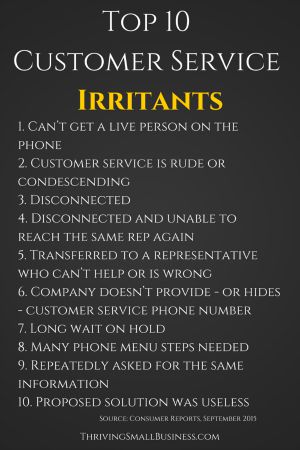7 Things You Can Do To Fix What Irritates Your Customers
Estimated reading time: 5 minutes
Customer service has come a long way – at least, we think.
The past century has provided businesses with new technologies that help the business owner keep in contact with their customers and modify products based on customer feedback.
We can all remember a time when we had an over-the-top customer experience. As well, most of us can give more than one example of a nightmare customer experience.
Customers go into the buyer-seller relationship with one expectation. To receive the product or service that matches an implied promise.
This means that the customer expects a product or service to reflect what was described to them.
Businesses make implied promises through marketing materials, product descriptions, and social promotions.
For example, if a customer sees an advertisement for a product, they expect that product to perform the way it was described.

If a customer looks up a menu for a restaurant online, they expect the dining experience to match the look and feel of the descriptions.
Organizations have come to understand the importance of taking care of the customer, and many invest significant dollars into technologies that support the customer experience.
But even with all of this, it appears that the customer experience has not improved much.
The Consumer Reports National Research Center surveyed 1,016 adults about customer service pain points that ranged from annoying to irritating. The survey “shows that the company promises and even new technology haven’t made the customer-service experience much less painful…”
Also, “Half of the people we surveyed reported leaving a store without making their intended purchase because of poor service.”
According to Arizona State University, “satisfaction with service is actually no higher than it was in the 1970s.”
So what is that irritates the customer?
Top 10 Customer Service Irritants
- Can’t get a live person on the phone
- Customer service is rude or condescending
- Disconnected
- Disconnected and unable to reach the same rep again
- Transferred to a representative who can’t help or is wrong
- Company doesn’t provide – or hides – customer service phone number
- Long wait on hold
- Many phone menu steps are needed
- Repeatedly asked for the same information
- The proposed solution was useless
Eight out of these ten irritants have to do with phone calls and deal with employees who either haven’t had proper training, aren’t held accountable for actions, or disconnect between the way the customer expected the experience to be like and the way the call was handled.

So, what can you do to help counter these customer irritants?
7 Things You Can Do To Fix What Irritates Your Customers
1. Experience The Process
Oftentimes, we put systems and processes in place – and forget it!
The problem with this is there are many steps to a process, and unless you map out each step, as in a flow chart, you may not be seeing the big picture or the entire process.
For instance, I recently went to a website and was looking for a phone number. I clicked on the Contact Us link, and it took me to a dead page.
Unless you walk through the same steps as a customer will, you may be missing serious flaws in the process.
2. Monitor Call Center
Most call center software has capabilities to monitor caller phone calls.
You should be listening to how employees answer calls and coach employees on improved services.
For example, we all know that it’s not what you say but how you say it.
Listen to how employees speak on the phone and coach them on the best way to talk to customers.
3. Hold Employees Accountable
Employees should be given the tools and training to do their jobs before they are ever exposed to a customer.
Training should involve steps for performing job responsibilities, practicing the job, and coaching for improved performance.
Once the employee interacts with customers, they should be held accountable for what they learned in training and how they interact with customers.
No organization should ever receive a complaint about rude employees.
Those types of people should never be hired and should be eliminated in the screening and interviewing process.
However, if an employee does end up working for you and is found to be rude, they should be quickly corrected.
4. Talk to Complaining Customers
It is never easy to listen to someone who is complaining. However, if you can focus on the message instead of the delivery, you will often find gems of wisdom in what is said.
Customers have a unique perspective and can give you a realistic view of the experience. Listen to the questions customers ask and look for answers to those questions.
And, if you can get them talking, they can often shed light on ways to improve – a gift that many businesses neglect to take advantage of.
5. Benchmark Best Practices
Many organizations do this right. Benchmarking is a way to seek them out and try to learn what they do that is different.
Take what you learn and incorporate it into improved processes, systems, and training for employees.
6. Learn From Data
Take advantage of the data you already have and try to learn what numbers can be improved.
For example, study hold times, dropped calls, number of transfers, and customer call length. Use this type of information to determine staff levels and training needs.
We all know that it is the customer who pays the bills. And, if you irritate a customer, you will probably lose them – something no business can afford.
Invest the time and money into technology, training, and learning.
Focus on the customer and their experience, do it right the first time, and every time and your organization may be in the minority of businesses that do it right and delight their customers.
How many of these irritants do your customers experience?






